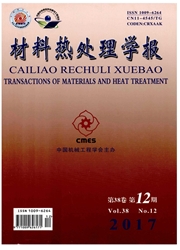

 中文摘要:
中文摘要:
通过光学显微镜、扫描电镜及透射电镜研究了热轧工艺对7050铝合金慢速率淬火过程的组织演变规律,并结合电导率及力学性能结果分析了热轧变形参数对合金淬火敏感性的影响。结果表明:变形程度越大合金表现出更差的淬火敏感性,这是因为轧制工艺不同将导致合金再结晶百分数差异,进而对合金淬火敏感性产生影响,根本原因是再结晶晶粒中的Al3Zr粒子作为平衡η相的形核位置将加快合金过饱和固溶体的分解,导致合金后续时效强化效果降低,合金性能损失;合金热处理过程中在保证力学性能的前提下,适当控制轧制变形量可减小再结晶分数,改善合金淬火敏感性。
 英文摘要:
英文摘要:
Microstructure evolution of 7050 aluminum alloy during solution and slow quenching treatment after different hot-rolling processing was studied by means of optical microscopy,scanning electron microscopy and transmission electron microscopy.Influence of the processing parameters on quench sensitivity of the alloy was examined by hardness and tensile tests.The results show that the quench sensitivity increases with the increase of rolling reduction for 7050 alloy.During solution treatment,the recrystallization plays an important role in the transformation of Al3Zr particles from the coherent to the incoherent by migration of grain boundaries,which promotes heterogeneous precipitation of η phase and lowers the maximum volume fraction of hardening precipitates when quenching at a low rate.Controlling the rolling reduction is an efficient way to inhibit the ratio of recrystallization and decrease the quenching sensitivity of the alloy.
 同期刊论文项目
同期刊论文项目
 同项目期刊论文
同项目期刊论文
 期刊信息
期刊信息
